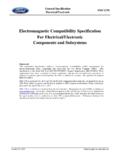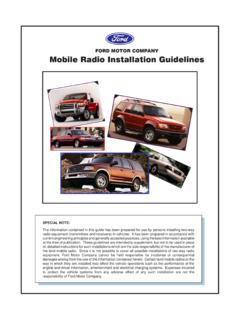Transcription of Differences between EMC-CS-2009.1 and FMC1278
1 REVA 7/05/2015 Differences between and FMC1278 The following is a brief summary of the major Differences between the current specification and FMC1278 . Forward Requirement references changed to align with CPSC related requirements within FSMS. The scope of requirements now includes 24 VDC systems. The specification is limited only to 12 and 24 VDC systems. Section Vehicle Level Requirements References to specific vehicle level ARL requirements have been replaced by general reference. Section Use of this Specification Clear stating of the fact that compliance of component/subsystem requirements are the responsibility of Ford Motor Company. The supplier may not self certify. Section 4 Functional Classification/Status Functional Classification definitions updated to align with ECE Regulation Functional Status definitions to clarify and better differentiate between Status II and Status III.
2 Section Load Simulator Clarification made that Load Simulator is bonded directly to the ground plane Section Artificial Networks Notation that use of artificial networks will deviate from CISPR/ISO standards. In most cases, only one artificial network on power to DUT will be included. Section Tolerances. Tolerance on electric/magnetic field strength in addition to power/current changed from 10% to -0/+1 dB. Section Power Supply Parameter expanded to include 24 VDC power. The use of the term power supply to, by default be a regulated source. This replaces the previous default to use an automotive battery. For RF emissions testing, a linear regulated power supply must be used to assure test setup ambient requirements are met.
3 Section EMC Test Plans Text clarified to show that the test plan requires both sign-off by the EMC department and inclusion of a valid EMC test plan number before the test plan can be used for sign-off testing. Section Sample Size Still require two test samples. Requirement clarified to state that sample must be of identical design/function. REVA 7/05/2015 Section Sequence of Testing. RF emissions and immunity are recommended following ESD testing. Damage to either sample requires immediate contact of and direction from FMC EMC. Failure to do will likely invalidate the test results. Section Data Reporting With respect to immunity testing, the laboratory may not use of the terms pass or fail.
4 They may only report Status I, II or III. FMC will make determination of pass/fail based during their review of the formal test report. Section 7 Requirement Applicability Replace component category P and R with categories D and R. Improved definitions driven by need for better definition of LED functions. o Active and passive ignition coils are now included along with fuel injectors. CE 420 is now required for passive ignition coils ( DIM) 12 and 24 VDC systems are included. Table 7-1 now serves as central point for determining applicability. Redundant applicability references have been removed from individual requirements. Section Specification now fully compatible for use ESA type approval per ECE Regulation Additional requirements in table ( ) added to facilitate this.
5 Section 8 RE 310 Level 2 requirements now requires compliance to both PK and AVG limits. Previously either limit was acceptable. Long Wave (EU1), Police (EU4), and DAB (EU7) frequency bands have been eliminated. Some band designations have been reassigned to continue alignment between Ford and GM. EU4 band reassigned to now include GLONASS band. GPS (G8) band limits reduced by 6 dB to facilitated compatibility for customer installed GPS devices. Clarification provided to required FMC review/concurrence before AVG limits are imposed on intermittent use devices. Test setup now only uses a single Artificial Network on power. DUT power return connected to ground plan at Load Simulator Special test setup for engine control electronics has been eliminated.
6 Use of Fast Fourier Transform (FFT) may be used by any receiver that is fully compliant to CISPR 16-1-1(2010). Swept receivers ( spectrum analyzers) may no longer be used. Bandwidth reduction for band G1 (AVG limit) may no longer be used unless prior approval attained from FMC EMC. If allowed the reduction can be no lower than 1 kHz. Bandwidth for Bands G8 (GPS) and G9 (GLONASS) may be reduced to 5 kHz to meet ambient requirements for new lower limits. Above 1 GHz, DUT shall be tested in 3 orthogonal positions. This aligns with existing requirements for RI 114. REVA 7/05/2015 Section 9 CE 420 Applicability further expanded to exclude all electric motors/actuators that operate intermittently with an active duration less than 2 second.
7 This is combined with the existing requirement on electric motors/actuators that operate intermittently AND with direct operator control via depression of a switch. However these exclusions do not apply if the device is expected to be packaged within 300 mm of the vehicle s radio antenna. EU1 band eliminated. G1 band reduced by 6 dB for better correlation to RE 310 limits. Measurement system requirement changes consistent with those for RE 310 Section 10 CE 421 Limits are now in terms of current as opposed to voltage. Current levels based on level required to achieve compliance to EMF guidelines delineated in ICNRP 1998. Test setup changed to facilitated direct measurement of current.
8 Measurement receiver must be compliant o CISPR (2010). Use of FFT is allowed. Current probe characteristics included to provide guidance. Section 11 CE 410 Requirements expanded to include limits for 24 VDC systems. Limits based on those from ECE Regulation Time base requirement of eliminated to facilitate reduced test time. Detail included in the test procedure pertaining to the method to assure that maximum transient magnitudes have been captured. Section 12 RF Immunity Notes regarding special requirements for audio removed from Acceptance criteria. RI 112, RI 114 and RI 115 all eliminate Artificial Network from power return of DUT. This is consistent with changes for RE 310.
9 Thresholding process modified and clarified. Alternative test procedures may be allowed ( TEM for key fob), but requires prior approval by FMC EMC. Occurrence is expected to be rare. Test frequencies specifically called out. This replaces fixed frequency steps. Frequencies match with test frequencies used for vehicle level testing. Section RI 112 Level 1 and Level 2 limits modified particularly below 15 MHz. Band designations modified DBCI now required from 1 60 MHz. Previously it was from 1- 30 MHz. CBCI required from 20-400 MHz for compatibility to ECE Regulation Test setup now only uses a single Artificial Network on power. DUT power return connected to ground plan at Load Simulator Injection probe required to be single turn primary.
10 Untested wiring shall remain bundled together with wiring under test except at injection probe. Wiring is wrapped around the outside of the injection probe. Monitor probe is not used unless first approved by FMC prior to commencement of testing. REVA 7/05/2015 Section RI 114 Band designation modified. Example; Band 4 now become Band 5 Band 5 frequency band now starts 360 MHz Clarification that use of Reverberation is preferred method therefore shall always be used when available. Test setup now only uses a single Artificial Network on power. DUT power return connected to ground plan at Load Simulator Clarification that that Battery is located directly on dielectric support clarified for MTR method.







